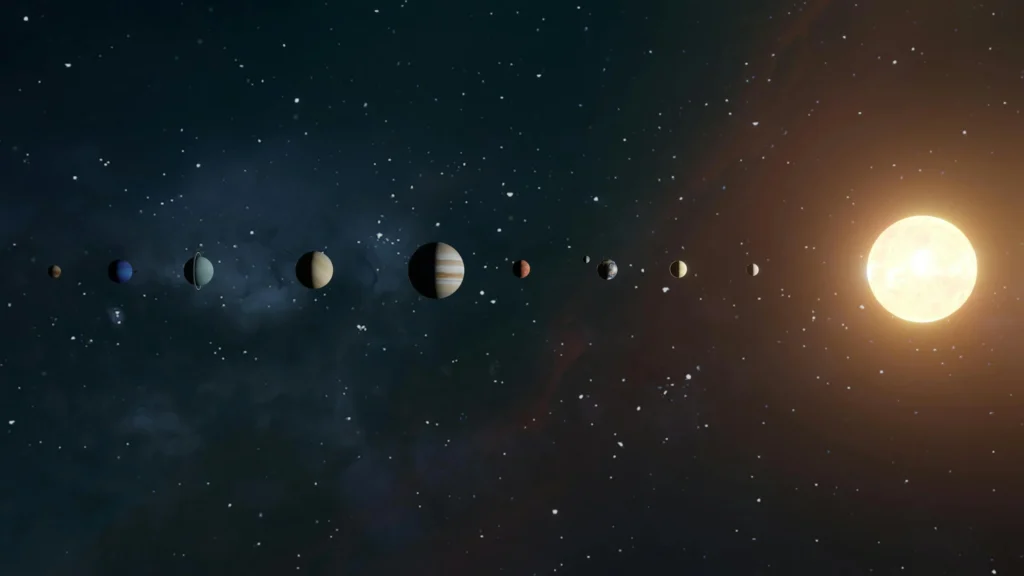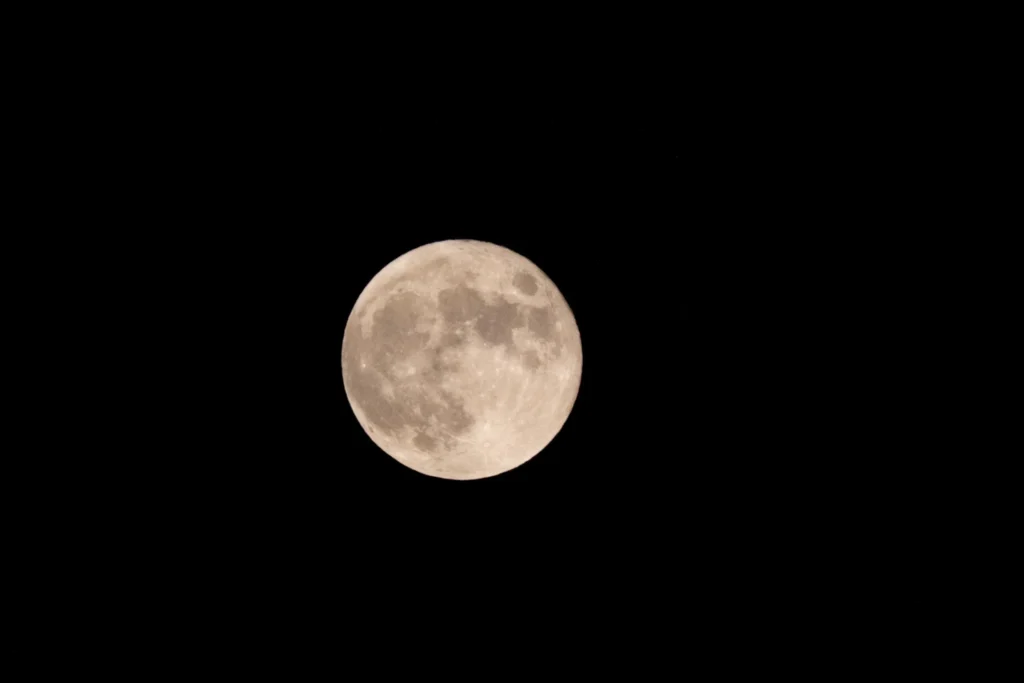In this article, we’ll take you on a journey through our solar system, exploring its many wonders and mysteries.
Overview of the Solar System
Our solar system is a vast and fascinating place. It consists of the Sun, eight major planets, numerous moons, and countless asteroids and comets. This incredible system formed about 4.6 billion years ago from a giant cloud of gas and dust. Understanding the structure and components of our solar system helps us appreciate the intricate balance and beauty of the cosmos.
The Sun: The Center of Our Solar System
The Sun is the heart of our solar system. It is a giant ball of burning gas that provides light and heat to all the planets. The Sun’s gravitational pull keeps everything in orbit. Without it, our solar system wouldn’t exist. Did you know the Sun contains over 99% of the solar system’s mass? It’s truly a powerhouse!

Characteristics of the Sun
- Mass: 1.989 x 10^30 kg
- Diameter: 1.392 million km
- Surface Temperature: 5,500°C
The Sun goes through cycles of solar activity, such as solar flares and sunspots, which can affect satellite communications and power grids on Earth. Its life cycle, from birth to eventual death, spans billions of years, during which it will eventually become a red giant and then a white dwarf.
The Inner Planets: Mercury, Venus, Earth, and Mars
These four planets are closest to the Sun and are known as the terrestrial planets because they have solid, rocky surfaces.

Mercury: The Closest Planet to the Sun
Mercury is the smallest planet in our solar system and has no moons. It orbits closest to the Sun, making it a hot and barren place. Despite its proximity to the Sun, it has a very thin atmosphere, so temperatures can swing drastically from extremely hot to extremely cold.
Venus: The Hottest Planet
Venus is often called Earth’s twin because of their similar size and composition. However, Venus has a thick atmosphere rich in carbon dioxide, causing a greenhouse effect that makes it the hottest planet in our solar system.
Earth: Our Home Planet
Earth is the only planet known to support life. Its unique biosphere is made possible by a perfect balance of atmosphere, water, and temperature. The Moon orbits Earth, influencing our tides and stabilizing our climate.
Mars: The Red Planet
Mars, with its striking red color from iron oxide, has captured our imagination for centuries. It has the largest volcano in the solar system, Olympus Mons, and a canyon system, Valles Marineris, that dwarfs the Grand Canyon.
The Outer Planets: Jupiter, Saturn, Uranus, and Neptune
The outer planets are also known as the gas giants (Jupiter and Saturn) and ice giants (Uranus and Neptune). They are much larger than the terrestrial planets and have numerous moons and ring systems.
Jupiter: The Largest Planet
Jupiter is the behemoth of our solar system, with a mass more than 300 times that of Earth. It has a Great Red Spot, a giant storm that has been raging for centuries. Jupiter has 79 known moons, including Ganymede, the largest moon in the solar system.
Saturn: The Planet with the Rings
Saturn is renowned for its stunning ring system made of ice and rock. It has over 80 moons, with Titan being the most notable due to its thick atmosphere and surface lakes of liquid methane.
Uranus: The Ice Giant
Uranus is unique because it rotates on its side, making its axial tilt nearly 98 degrees. It has a faint ring system and 27 known moons. Its blue-green color comes from methane in its atmosphere.
Neptune: The Windy Planet
Neptune is known for having the strongest winds in the solar system, reaching speeds of up to 2,100 km/h. It has a dark spot similar to Jupiter’s Great Red Spot and 14 known moons, with Triton being the most significant.
Dwarf Planets and Other Objects in the Solar System
Pluto: The Most Famous Dwarf Planet
Once considered the ninth planet, Pluto is now classified as a dwarf planet. It resides in the Kuiper Belt, a region filled with icy bodies and other dwarf planets.
The Kuiper Belt and Oort Cloud
The Kuiper Belt extends beyond Neptune’s orbit and contains many small, icy bodies. The Oort Cloud is even farther out, a theoretical cloud of comets surrounding the solar system.
Moons of the Solar System
Notable Moons
- Earth’s Moon: Our nearest celestial neighbor.
- Europa: Jupiter’s moon with a subsurface ocean.
- Titan: Saturn’s largest moon with a thick atmosphere.
- Ganymede: The largest moon, orbiting Jupiter.

Moons come in various shapes and sizes, and some, like Europa and Titan, are considered potential places for finding extraterrestrial life.
Asteroids, Comets, and Meteoroids
The Asteroid Belt
Located between Mars and Jupiter, the asteroid belt is home to millions of rocky bodies. The largest asteroid, Ceres, is also classified as a dwarf planet.
Comets
Comets are icy bodies that originate from the Kuiper Belt and Oort Cloud. When they approach the Sun, they develop spectacular tails due to the sublimation of their icy nuclei.
Meteoroids, Meteors, and Meteorites
- Meteoroids: Small rock or metal objects in space.
- Meteors: Meteoroids that enter Earth’s atmosphere and burn up.
- Meteorites: Meteors that survive the atmosphere and land on Earth’s surface.
Space Exploration and Discoveries
Humanity’s quest to explore the solar system has led to many remarkable discoveries. From the Voyager missions to the Hubble Space Telescope, we’ve learned so much about our cosmic neighborhood. Future missions, like sending humans to Mars, continue to push the boundaries of what we know.
The Influence of the Solar System on Earth
The solar system significantly impacts Earth. The Sun’s solar radiation influences our climate, while the gravitational forces of the Moon and planets affect tides and other natural phenomena. Understanding these influences helps us prepare for potential threats like asteroid impacts and solar flares.
Conclusion
Our journey through the solar system has illuminated the intricacies of the Sun, planets, moons, and space exploration. Leave a comment, share with friends, or explore more on our site for the latest in space discoveries. Thank you for exploring with us!
Frequently Asked Questions About the Solar System
What is the solar system?
The solar system consists of the Sun and everything bound to it by gravity. This includes eight major planets, their moons, dwarf planets, asteroids, comets, and meteoroids. It is located in the Milky Way Galaxy and formed about 4.6 billion years ago from a cloud of gas and dust. [Sources: Britannica, Wikipedia]
What are the planets in the solar system?
The eight planets in our solar system, in order from the Sun, are Mercury, Venus, Earth, Mars, Jupiter, Saturn, Uranus, and Neptune. These are categorized into terrestrial planets (rocky) and gas/ice giants. [Source: NASA]
How did the solar system form?
The most widely accepted theory is that the solar system formed from a solar nebula—a giant rotating cloud of gas and dust. Gravity caused the nebula to collapse, forming the Sun at its center and the planets from the surrounding material.
Why is Pluto no longer considered a planet?
In 2006, the International Astronomical Union (IAU) redefined the criteria for planet classification. Pluto did not meet all the criteria because it hasn’t cleared its orbit of other debris, thus it was reclassified as a dwarf planet.
Are there more dwarf planets in the solar system?
Yes, besides Pluto, there are several other recognized dwarf planets such as Ceres, Haumea, Makemake, Eris, and potentially more in the Kuiper Belt and Oort Cloud.
How many moons are in the solar system?
There are over 200 known moons orbiting the various planets. Notable moons include Earth’s Moon, Europa and Ganymede around Jupiter, Titan around Saturn, and Triton around Neptune.
What are the asteroid belt and the Kuiper Belt?
The asteroid belt lies between Mars and Jupiter and is composed of rocky bodies and dwarf planet Ceres. The Kuiper Belt extends beyond Neptune’s orbit and contains icy bodies, including Pluto and other dwarf planets.
What is the Oort Cloud?
The Oort Cloud is a theoretical spherical shell of icy objects that exists far beyond the Kuiper Belt. It’s believed to be the source of long-period comets that enter the inner solar system.
Is there life elsewhere in the solar system?
While Earth is the only planet known to support life, moons like Europa (Jupiter) and Enceladus (Saturn) have subsurface oceans that may harbor microbial life. Mars is also a candidate due to evidence of past water activity.
How do we explore the solar system?
Humanity explores the solar system through spacecraft, telescopes, and robotic missions. Notable missions include Voyager, Cassini, New Horizons, and the Mars rovers. Future missions aim to explore Mars, Europa, and beyond.








